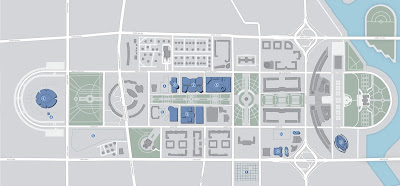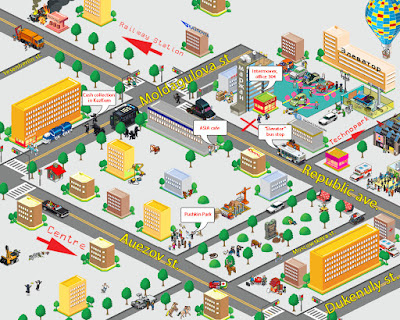This past Sunday was the 10th anniversary of Napyidaw, Burma's new capital. I did a post about how the country suddenly moved its capital far into the hinterlands with no explanation and under much secrecy. Much of the city is strangely empty according to those few outsiders who have visited. Totalitarian regimes like to keep their geographic knowledge to themselves. Another example is North Korea's Pyongyang.
Unlike Napyidaw, Pyongyang has a long history of settlement but because North Korea was closed off to foreigners after the Korean War, little is known of its recent development. An article from the Library of Congress, Geography and Maps Division shows some of the rare maps available outside the country including this guide for tourists attending a 1989 youth festival.
The map is surrounded by pictures meant to highlight power and modernity.
More from the Library of Congress article:
Another country that like Burma suddenly moved its capital to the far northern hinterlands is Kazakhstan. In 1997 they moved the capital from Almaty to the small city of Akmola and then renamed the place Astana, "the capital" in Kazakh. Moving the capital allowed the government to centrally plan a monumental capital city, one full of strange modern architecture.
The map above, though hard to read details the top ten architectural wonders of the city in blue. Those wonders are listed on this page, and include the Baiterek Tree of Life (below) as well as the world's largest tent, serving as a mall and entertainment complex and also includes a river, park and beach.
Here is a picture via CNN of the modernistic capital complex.
Despite being the world's second coldest capital and being surrounded by many hundreds of miles of mostly empty grasslands, the city does have more life than Napyidaw. It is also much less secretive. Here is a cartoon-ish map of one of the business districts north of downtown, itself a ways north of the capital complex.
Lastly, I've always wanted to show some maps of Brazil's capital, Brasilia. While not the product of a totalitarian state, it is also a highly designed landscape created from a mostly blank slate. The design is meant to look like a giant bird or airplane. It looks cool on maps and aerial photos. On the ground, however it's a pretty bleak landscape. Here is the original plan followed by a map.
Here is a night shot from the International Space Station via Wikipedia.
Like these other capitals, they favor modernistic architecture.
On the ground however, it does not look like a warm, inviting place.
Unlike Napyidaw, Pyongyang has a long history of settlement but because North Korea was closed off to foreigners after the Korean War, little is known of its recent development. An article from the Library of Congress, Geography and Maps Division shows some of the rare maps available outside the country including this guide for tourists attending a 1989 youth festival.
The map is surrounded by pictures meant to highlight power and modernity.
More from the Library of Congress article:
Those who manage to enter the city are chaperoned and follow a strict itinerary; the practice serves to perpetuate both curiosity and mystery. Fortunately, geographic knowledge of the city has been growing by way of satellite imagery. Satellites, however, can only depict but cannot describe.Click for for the full article.
Another country that like Burma suddenly moved its capital to the far northern hinterlands is Kazakhstan. In 1997 they moved the capital from Almaty to the small city of Akmola and then renamed the place Astana, "the capital" in Kazakh. Moving the capital allowed the government to centrally plan a monumental capital city, one full of strange modern architecture.
The map above, though hard to read details the top ten architectural wonders of the city in blue. Those wonders are listed on this page, and include the Baiterek Tree of Life (below) as well as the world's largest tent, serving as a mall and entertainment complex and also includes a river, park and beach.
Here is a picture via CNN of the modernistic capital complex.
Despite being the world's second coldest capital and being surrounded by many hundreds of miles of mostly empty grasslands, the city does have more life than Napyidaw. It is also much less secretive. Here is a cartoon-ish map of one of the business districts north of downtown, itself a ways north of the capital complex.
Lastly, I've always wanted to show some maps of Brazil's capital, Brasilia. While not the product of a totalitarian state, it is also a highly designed landscape created from a mostly blank slate. The design is meant to look like a giant bird or airplane. It looks cool on maps and aerial photos. On the ground, however it's a pretty bleak landscape. Here is the original plan followed by a map.
Here is a night shot from the International Space Station via Wikipedia.
Like these other capitals, they favor modernistic architecture.
On the ground however, it does not look like a warm, inviting place.






































